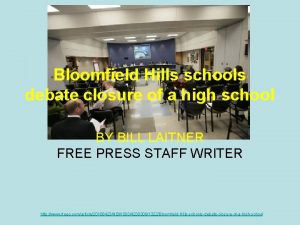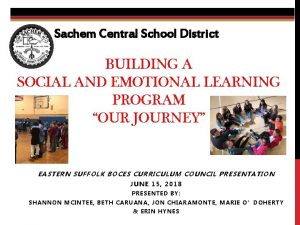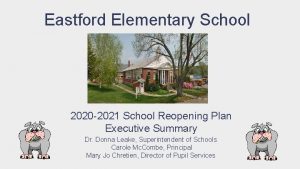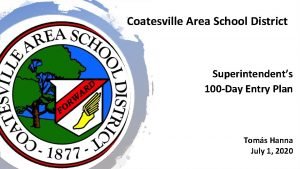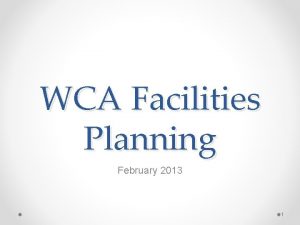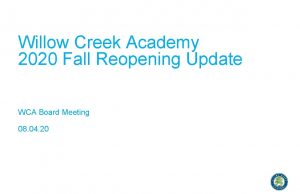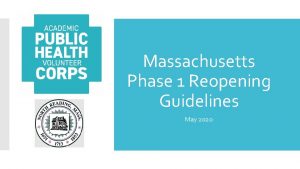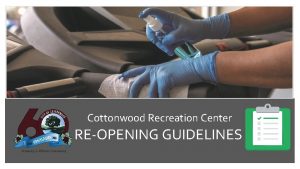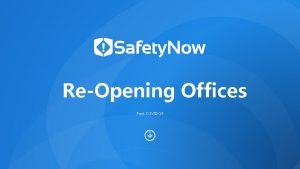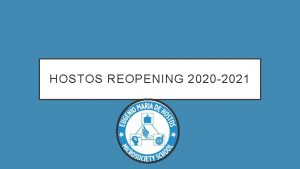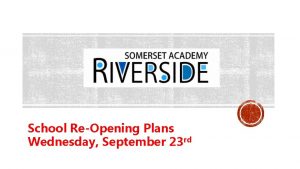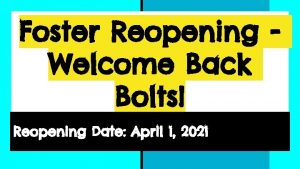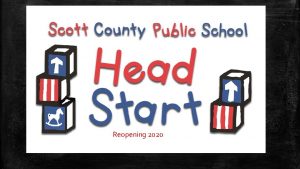WCA Reopening Update Where Are We Now On












- Slides: 12

WCA Reopening Update

Where Are We Now? -On Campus Cohorts ● 68 students in grades K-6 were invited to come to campus. ● 43 (13% of students) Students are on campus, in 8 small cohorts ○ ○ Cohorts in Grades K-5 ■ Kinder- 2 students ■ 1 st Grade- 13 students ■ 2 nd Grade- 10 students ■ 3 rd Grade- 6 students ■ 4 th Grade- 11 students ■ 5 th Grade- 1 students 22 English Learners 11 Students With IEPs 33 Free/Reduced Lunch

Where Are We Now? -On Campus Cohorts ● Staff Members on Campus ○ 6 classroom teachers ○ ○ ○ 1 assistant teacher 3 Student Support Specialists 1 School Counselor 1 Intervention Specialist Admin 2 Kitchen staff ● In-Person Info ○ ○ Students on campus 8: 30 -12: 30 Students have 2 check-in points where temperatures are taken Students are provided breakfast and lunch Students with IEPs are receiving in-person services

Where Are We Now? -MC Learning Hub ● Approximately 48 students were invited to participate in the MC Community Learning Hub ● 15 WCA Students are Enrolled in the Hub ● ● ● ○ 5 th Grade- 2 students ○ 6 th Grade- 3 students ○ 7 th Grade- 7 students ○ 8 th Grade- 3 students 1 English Learner 6 Students With IEPs 13 Free/Reduced Lunch *Beginning October 19 th, these students will return to campus. This will bring the on-campus numbers to 58 students, or 17% of our total student body.

Where Are We Now? -Family Survey ● 278 Responses (not including duplicate responses) ● Phone calls to families we haven’t heard from began last week. ● 215 Families said Likely or Highly Likely to return when safe to do so, but… ○ ○ 74 Families said they feel safe to come back in red (substantial risk) 65 Families said they feel safe to come back in orange (moderate risk) 76 Families said they feel safe to come back in yellow (minimal risk) 63 Families said they want to remain in distance learning all year ● 82% of families feel that distance learning is working ● 75% of families feel like there is the right amount of work

Additional Comments from Family Survey! What is working well for your family in distance learning? ● ● ● “The new interphase is so much better and more clear. Teachers communicating directly about what is due which day has also been super helpful. ” “AMAZING teachers” “Interactive Lessons that engage the students” “My kids teachers are awesome” “Teachers/admin are super responsive, very happy with the consistent schedule for breaks and lunch for both kids. ” “Distance learning is not ideal, but you guys are doing a great job. ” How could we improve your family’s distance learning experience? ● ● ● “Shorter amount of time in front of the screen. ” “Reduce the amount of classwork. ” “Increase the amount of classwork. ” “Provide more opportunities for student to student interaction in remote classes. ” “Financials aside, having a tutor or more hands on from 2 -3 during academic choice time”

Assessment and Engagement ● We are using many forms of assessment, including F&P, MAP, writing prompts, News. ELA, Dreambox and Thinkwell ● Reading and math data will be available for students K-8 by early November ● Also using Clever to track daily engagement and assignment completion ● Student attendance/engagement has increased since the spring ○ ○ Attendance: 95. 8% of students were in attendance in September Engagement: 85% of students are fully engaged in DL (completing above 70% of their work), according to teacher data ■ 5% of the 85% are on campus or at the hub ■ 8% of the remaining 15% were invited but declined due to health/safety concerns ■ Only 4% of the remaining 15% are completing less than 50% of their work, and these are the families our student support specialists are continually reaching out and offering support to

Supporting high needs students ● On-Campus Cohorts made up of high needs students, and Remote support for students who are not on campus ● All weekly grade level meetings dedicating first 15 minutes to TLC students, joined by Student Support Specialists, admin and counselor ● 7 th and 8 th grade teachers invited BTG teachers to team meeting 10/13 to discuss shared students ● Math and Literacy Specialists maintain one shared student data spreadsheet for all staff to access to guide conversations and regularly update.

Supporting high needs students (cont) ● Coach Lynette also supporting effort as Family and Community Outreach Coordinator and Co-Director of MC Community Hub ● Literacy Specialist serving as academic liaison with MC Community Hub, attending weekly meetings with admin, BTG, Coach Lynnette ● Former colleague of Emily from Boston Public Schools, trained Reading Recovery Coach and Literacy Specialist volunteering to support first grade teachers and students.

Supporting all students- Lessons Learned ● ● ● Being online (Zoom breakout rooms) has increased teacher’s ability to work with kids in small groups/individually compared to in-person Using distance learning as an opportunity for more co-teaching, visiting each others classrooms, sharing best practices, integrating volunteers to support small break-out rooms and individualized support. Teachers have designed lessons that allow for PBL on Zoom Teachers who are on campus and teaching cohorts are happy with being able to engage at-risk students in person, but also struggling with balancing in-person and online engagement. Teacher feedback has been that if they are asked to split their attention between students who are in-person and those who are remote, they will not be able to provide as robust of a curriculum.

Bringing More Students Back Challenges Solutions Internet Bandwidth-in order for teachers to have students in the classrooms and teach via Zoom, the aging infrastructure needs to be majorly upgraded ● Support Staff- in order to support teachers having more students on campus, they will need additional assistant teachers to support in classroom students while they focus on students who are online ● ● CARES funding will support some hires Will need to find additional funding to hire additional staff Safety/Logistics ● Scheduling on-campus vs. remote learning ● Campus Cleaning ● Space for additional cohorts/recess space ● Air Quality in Classrooms ● Plans for inclement weather/power outages ● ● Air filters in classrooms Staff meetings to plan for scheduling, inclement weather, power outages, etc. Additional oversight for campus cleaning ● ● Additional routers placed in classrooms where cohorts are places Dr. Garcia is working to upgrade the aging internet infrastructure

Next steps ● Continue to strengthen on-line instruction for all students through PD and sharing best practice ● Pricing out “Securly” which would allow teachers and parents to monitor student screens and activity ● Use student performance/attendance data and family survey results to understand expected on-campus/remote population ● October 19 th- Bring MC Hub students to campus ● Hire 2. 5 teacher assistants to support in-person learning ● November goal - Execute tech-first approach to support on-campus and remote family choice ● Reassess county guidelines to set post winter break plan
 Insidan region jh
Insidan region jh ........ is an alternative of log based recovery.
........ is an alternative of log based recovery. Ibm campaign download
Ibm campaign download Bloomfield hills schools reopening
Bloomfield hills schools reopening Sachem school district
Sachem school district Lincoln parish school board
Lincoln parish school board Reopening plan
Reopening plan Tomas hanna coatesville
Tomas hanna coatesville Nadia nashir
Nadia nashir John fabrizio merrimack nh
John fabrizio merrimack nh Now i see it now you don't
Now i see it now you don't Gtcs spr
Gtcs spr Igel ums firmware update
Igel ums firmware update



